Refine by Region
Refine by Art Form
Refine by School Level
Virtually There with St Patrick’s P.S. Co Armagh

Action Painting
Tell us the story of your project – What was the impetus? What was it about? Who was involved? How did you begin?
Sharon Kelly, Artist: This was the second year of working with Fionnuala at St Patrick’s Primary School, although I have been a ‘virtual’ artist in residence since 2010. In September 2016 we had agreed to base our explorations for this phase of the project around the idea of Balance. The ‘way in’ to this came to me as I was moving studio at that time, leaving a building inhabited since 1993, and moving into an old building that was once the main fishing tackle shop in Belfast. The former inhabitants left behind a lot of things, one of which was an old wages and salaries book from 1904, called Time Book. I thought this could provide inspiration to generate ideas about balance. Fionnuala was really open and willing to take this route, which seemed at first a little obscure.
What struck me was the old fashioned ink script that recorded names and hours worked, it was of course a balance of sorts, balancing the books, but what really interested me was the beautiful controlled letters flowing in ink, balanced between the lines on the page. I left the book at the school after an introductory first visit and waited to hear the children’s response as they held, looked and smelled the book! It was the starting point for investigating what sort of balance and control we try to exert as we write our names. I was interested in the WAY we do this, how we use our body. Importantly I have been collaborating with dancers over the past 3 years and that particular project was beginning to come to fruition. Awareness of the way we move, tempo and gesture interested me. I also facilitate drawing classes with young people and adults once a week and this experience has meant that we often take time to explore the way we make marks and the many aspects that affect mark–making/expression.
How were the ideas developed and how did the young people, artist and teacher work together?
Sharon: The ideas developed through a process of questioning, taking something seemingly basic as writing your name and asking how do we do that. The P3/4 children were beginning to learn joined up writing, practicing making their letters flow continuously one into another. For our on-line sessions we spent time identifying what parts of our body we use to make letters as we write, mostly small movements with our hand and wrist. Together we began mimicking loops in the air and expanding the gesture to move more and more of our arm and then whole body. When we tried this in practice, the children discovered that if they utilized their whole arm and shoulders to make their loops, they could no longer write on small pieces of paper.
This exploration went from A5 size paper on their classroom desks to large scale loops on table-scale pieces of paper and out into the yard with chalk! The responses to this were very interesting because the children told me that they used a different energy and body weight to create these larger swirls. This real experience, supported by the wonderful way Fionnuala can elicit responses from the children for discussion, was a very important prompt before we took time to look at and take inspiration from the free-flowing script of Chinese writing and later the work of artists Cy Twombly’s Blackboard paintings from the 1970’s and the action painting of Jackson Pollock. (This was done by posting links to the classroom; the children and teacher would watch a video or view the work of the artists and a detailed discussion would take place).
Following this exposure to the action painting of Jackson Pollock in particular, Fionnuala thought it would be really worthwhile to allow the children to actually explore using paint and their bodies the way that Jackson Pollock had done. We planned that I would make a real visit to the classroom and we would all experience what it is like to paint on a large canvas surfaces on the floor and to engage our whole bodies in the process. It was an investigation into how much control we could use to drip, pour and splatter the paint. The children used many different implements to get paint onto the canvases brushes; sticks; sports cones that dribbled out paint; syringes; baby bottles.
In a sense we were experimenting with balance, exploring how we balance our bodies to create a gesture on the canvas and allowing enough freedom for spontaneity. It was a very potent mix and the outcomes on the floor were amazing to all of us. This very intense activity was followed by discussion, both on how we made the floor paintings, and what we thought about them. To further cement our ideas about balance we engaged the help of a friend of mine, Marie Murphy, Professor of Health and Fitness at Ulster University. We connected online via Blackboard Collaborate software. Professor Murphy invited us all to try some balancing postures, which proved to be a wonderful cool- down for the busy activity that preceeded it! Through the whole process we questioned, tried things out and reflected on what we observed, felt and understood. These beginning explorations provided a rich well to go on and explore gravity, air pressue, movement through space and in drawing (animations) and finally to explore space itself beyond the classroom, the school and the boundary of our planet!
Fionnuala Hughes, Teacher: We made loopy movements in the air, and then we tried to recreate them on large pages using graphite sticks, restricting our movements by keeping one arm behind our back. Some of the pupils were able to create looped designs with amazing uniformity and regularity in their designs, showing a great deal of control and an awareness of the overall effect which was being achieved. There was again intense concentration involved. The children used a great amount of energy, travelling as they worked, all the time keeping their chalk in contact with their canvas and exerting a huge degree of control and balance over their own bodies as they moved through their wonderful loopy designs. The work was challenging physically, but the children were very focussed on the tasks and the end results were wonderful. We had an entire playground covered in unique loopy designs and spiral patterns.
Technically the work involved a great deal of concentration and energy as well as allowing time to drip the paint onto the surface. Jackson Pollock’s tools never actually touched the canvas on which he was working so the concepts of Balance, Control and Gravity were important aspects of the children’s work. Again there was immense concentration on the part of the children; many of them found that they had to restrain themselves from pouring the paint onto the canvas instead of allowing gravity to play a part and control how they could drip the paint onto the surface in fine angel hair lines and criss-cross patterns as well as the splatter effect which was more random. Encouraging the children to control the flow of paint, and to exercise patience and restraint posed too great of a challenge for some pupils who chose quantity over quality. Keeping the paint pots full as the groups moved around the boards was not a simple task, and altogether we used over 12 litres of paint as well as a fair amount of PVA glue and several litres of water. The end results were pretty amazing and the children were justifiably proud of their results. Moving the boards out of the room to dry proved tricky and there was some movement of paint took place during this procedure however it did not detract from the overall effect. We had a very interesting and physical session in which the children explored balance and control using their bodies. They were only too happy to participate in these activities and enjoyed the challenge of balancing using different parts of our body to control and distribute our weight. Professor Murphy, via collaborate link, gave the children some tips as to how they could distribute their weight and maintain their balance for longer. The children were fascinated by his apparent ‘scribbles’ and we discussed what we had just done and what his work suggested to us.
What was your personal experience of the project in terms of successes and challenges?
Sharon: The whole project, which has just finished for now, was a wonderful journey in so many ways and these beginning sessions were very memorable for me. It is also true to say that the sorts of activities we have pursued, painting using control and balance of our whole bodies, meant that there were several ‘challenges’ to deal with, the attitude of those involved in the project, Fionnuala, Eileen the classroom assistant and the Principal of the School, Mr. Madine, were wholly supportive and this led to the success of the project. When we communicate online it can present challenges, some are technical problems that have to be overcome or they can be certain challenges in the way we interact. Some things are not immediate, we have to wait; to give time for things to develop – but I see this as contributing to the important ethos of the overall purpose of the project. Exploring, working collaboratively over time. After the practicing large scale loops and scribbles, Fionnuala made the observation that she had noticed the children’s handwriting had improved considerably, they were more confident with their joined up writing!
Fionnuala: The project enabled me as a teacher to get to know the pupils in my class very closely. I became the facilitator as opposed to the teacher and their project work was purely expressive. There was no right or wrong way and this enabled them to express themselves in whatever way they chose. Everything was valued. There was no fear. All was relevant. There was a lot of discussion where the children’s’ voices drove the ideas forward from session to session. Their engagement in the activities was always complete and they were immensely proud of any work which was produced as a result of the sessions. Their self-esteem and confidence grew with each session. The challenges were always practical. How can each child participate fully in each activity with equal access to the resources being made available? This involved considering the length of each of the activities ineach session and what order we might explore them in to allow time to rearrange the room during breaktimes,etc. we usually set up for art the day before so we had a blank canvas instead of a regular classroom to begin with!
On a personal level for me, the links which Sharon sent during our pre-session planning directing me to explore and discover the likes of Jackson Pollock or William Kentridge, neither of whom I’d heard of before. This prompted in me an interest into an area which I’d never delved into before. Involvement in the project broadened out my whole understanding of art as we began to ‘think outside the box’. Sharon was very good at lending me books from her own personal collection to develop my appreciation of art.
What was significant for you about the project that is worth sharing?
Sharon: The emphasis on process and discovery is really significant in this project and while Fionnuala and I plan sessions, they are generated out of what happened in the previous session and after a period of reflection. I am always interested in ‘disrupting’ the space of the classroom and the way the children spend so long sitting at desks. Many of our online sessions require that the space of the room be used differently. Fionnuala is always great at organizing the space to suit our activities. The children experienced drawing inside, outside, in the air, on the classroom floor and in many different scales.
I particularly liked the fact that we took something like writing your name, in school we must do this repeatedly usually in a particularly small scale, and analyzing everything about the way we do that. The practice of creating loops and giant scribbles and the feeling of ‘being in your work’ was invaluable since it helped generate ideas that we continued to explore about movement, balance, counter balance and feeling. Also in school we are not encouraged to ‘scribble’ for the sake of it and I found it so refreshing that Fionnuala embraced all aspects of this activity. She clearly valued what the children were doing and she was always willing to create the necessary space both physical and importantly the creative mind space. This was so evident when we explored during the real visit, the way we could control and balance our bodies to ‘paint’ the canvases on the floor of the classroom, taking Jackson Pollock’s work as inspiration. The inevitable ‘mess’ created was never a barrier! The important thing was that the children were able to have a significant experience.
Fionnuala: The project has had a significant impact on the children’s personal growth and development. It has also encouraged them to work together in teams to produce composite pieces. It was a whole new type of learning in which they were encouraged to get to know themselves, their bodies and how to use their bodies to create and draw. The activities usually meant that the children were up and out of their seats. Desks disappeared and the classroom became an art studio. The only boundaries were the children’s imaginations. We travelled across the globe, to outer space and back again, exploring concepts such as balance, control, and gravity, using their bodies and minds in harmony, to suspend disbelief and make the space become whatever they needed it too. The children worked closely and in harmony together. I do believe that the art session with Sharon was a special time in the week, when the children could forget about their worries and do something for themselves. They became totally engrossed and involved. Their inhibitions disappeared. The fact that another adult, a real artist, was placing such a significant value on their contributions raised their self-esteem enormously.
The day we did the “Jackson Pollock masterpieces” the children had such enormous fun exploring the whole concept of control and dripping the paint onto the canvas. The sheer size of the canvas was enough to excite them as they had this massive area to work in and there was no-one telling them what to do. It was pure self-expression and they absolutely loved it. The animation sessions were also very appealing to the children and the idea of making moving images from still drawings inspired the way they looked at movement and how much we take for granted without thinking how much work goes into a single animation.
Has anything changed in your work as a result of the project?
Sharon: Working on Virtually There Project continues the notion of the artist, children and teacher sharing explorations together and the spirit of this feeds into my thinking in my own work in a more subliminal way. Sometimes it can elicit an idea for a piece of work, something a child says in response to something has triggered an idea. However mainly it’s the way that you are able to develop the relationship over time, that allows you this wonderful window into the life of the school and those who pass through it, this has an impact on my thinking and contemplations about what I consider in the studio and outside.
Fionnuala: I feel that my approach to art in the classroom has changed in that I no longer focus on just the end product but I now value the whole process of doing and creating something. I tended to stick to drawing still life, and everyone created something similar, whereas now I see the value of providing the children with the tools, discussing ideas and letting them express themselves more freely. We had opportunities to use artistic medium which the school normally wouldn’t provide, such as willow charcoals, oil pastels and paints, as well as a range of papers, brushes and implements to create and express.
The best thing about the project is the insight it has given me into my pupils, and that special time we spent together during the sessions, as a class, creating and bonding. The relationship with Sharon has been central to that process, as she is always positive, questioning the children in a way that elicits very personal and interesting responses. It’s been great having the opportunity to work closely with Sharon, sharing ideas as we journeyed through the school year together. I look forward to working with her again in the future and feel privileged that I have the opportunity to work with such a talented person as Sharon, on an arts in education project which contributes to the holistic development of the children in such a positive way.
Spotlight
Artist(s):
I have been a practicing artist for 30 years and am still enjoying discovering and learning! My practice centres around drawing and the creative process. I have spent time making drawing animations, which have been largely about marking time in some way or about marking psychological landscapes – about feeling.
In recent years I have made work in collaboration with dancers/choreographers – most recently initiating a project with a writer that eventually developed with Maiden Voyage Dance, Belfast involving music and sound and came to fruition as a dance piece through a collaborative process.
I have been involved with Virtually There project for 7 years and really feel that I have been lucky over that time to work with wonderful teachers in St Patrick’s PS, Crossmaglen and now with Fionnuala I have the opportunity to build on the relationship over time, so it’s a real pleasure.
Teacher(s):
I have been teaching in St Patrick's Primary School, Crossmaglen for the past twenty two years. Every year is a new adventure with a whole new class of children. We've grown substantially over the years and have fifteen teaching staff so there are lots of projects going on in the school in any given year. I have been involved in many different types of projects but the Virtually There Project for me has probably been the most challenging as well as the most rewarding. The fact that it has grown from year to year is partly the reason for its success because as relationships have grown, this has strengthened the project.
Having now reached the end of my second year working on the Virtually There Project I can only say that it's been an extremely worthwhile journey for everyone involved. It's been hard work practically in the classroom as our class sizes are big (usually around 30) but it's been worth it to see the enjoyment and involvement of the children who undoubtedly will carry with them many memorable and worthwhile experiences in the years to come.
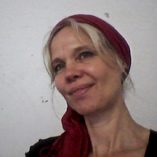
Artist(s)
Sharon Kelly

Teacher(s)
Fionnuala Hughes
Artforms
School Level
School/
Participant Group
St Patrick’s P.S. Co Armagh
No. Participants
27
Region
Age/Class
P3/4
Dates
October 2016 – May 2017
Weblinks
Leading Agency
Kids’ Own Publishing Partnership
Other Partners and/or Funders
The Paul Hamlyn Foundation, ACNI
Key themes/ lines of enquiry
Balance
Curriculum Strands
WAU
The sheer size of the canvas was enough to excite them as they had this massive area to work in and there was no-one telling them what to do. It was pure self-expression and they absolutely loved it.
Fionnuala Hughes, Teacher
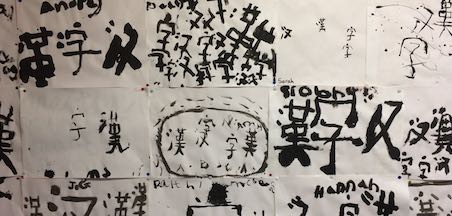


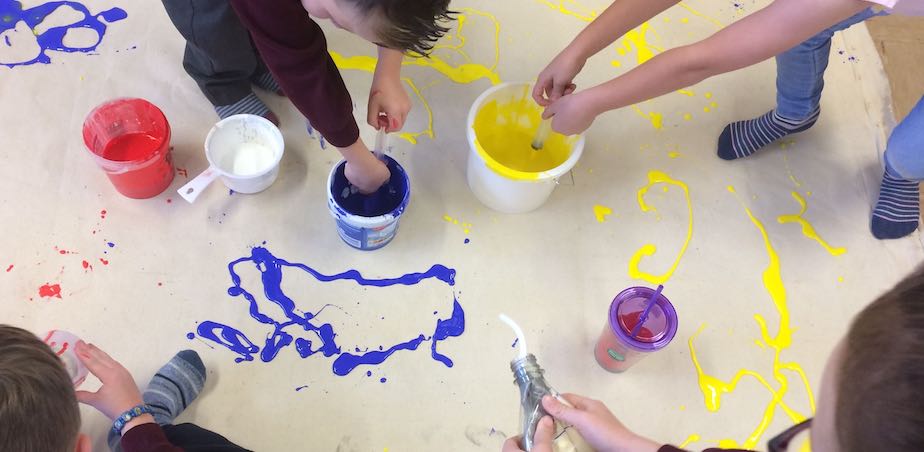
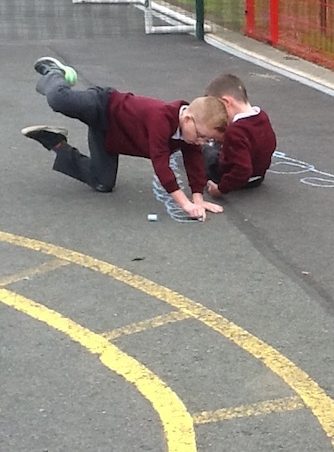

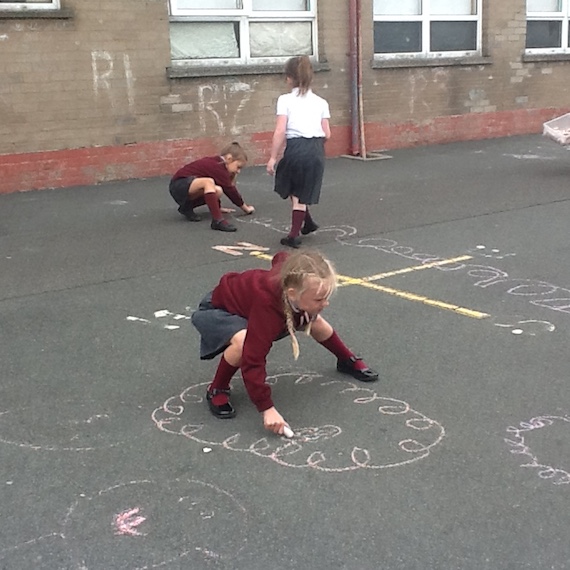
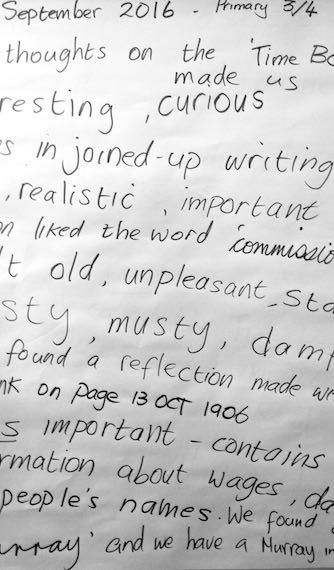
Similar Projects

Virtually There
Artist Vanya Lambrecht Ward collaborates with children from Ardfert National School, Tralee, via video conferencing technology.